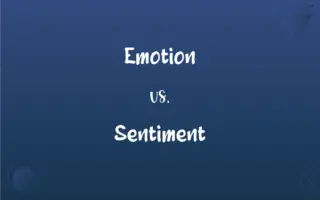Simple Harmonic Motion vs. Periodic Motion: What's the Difference?
Edited by Aimie Carlson || By Janet White || Published on December 23, 2023
Simple harmonic motion is a specific type of periodic motion where the restoring force is directly proportional to the displacement and acts in the opposite direction.

Key Differences
Simple harmonic motion (SHM) is a model for oscillatory motion where the restoring force is directly proportional to the displacement from an equilibrium position and acts in the direction opposite to the displacement. This results in a sinusoidal movement over time. In contrast, periodic motion refers to any motion that repeats at regular intervals, regardless of the nature of the forces involved. Periodic motion encompasses a broader range of motions, which include but are not limited to SHM.
The defining characteristic of simple harmonic motion is its restoring force, which is always directed towards a fixed point (equilibrium) and varies linearly with distance from it. This creates a predictable, sine or cosine wave pattern of movement. Periodic motion, on the other hand, is defined merely by the repetition of the motion in a regular cycle, such as the orbiting of planets or the swinging of a pendulum. The forces in periodic motion may or may not vary linearly with displacement.
In simple harmonic motion, the period and frequency of the oscillations are determined by the properties of the system, like mass and spring constant in a mass-spring system. This motion is symmetrical and time-independent. Whereas, in periodic motion, the period and frequency can be influenced by a wider range of factors and the motion may not necessarily exhibit symmetry or a sinusoidal pattern as in SHM.
An example of simple harmonic motion is a mass attached to a spring, oscillating back and forth. This motion is predictable and mathematically simple. In contrast, periodic motion examples include the Earth’s rotation around the sun or a ferris wheel turning, where the motion repeats but the forces involved are not necessarily proportional to displacement, nor is the motion sinusoidal.
Comparison Chart
Nature of Restoring Force
Directly proportional to displacement
Varies, not always proportional
ADVERTISEMENT
Type of Motion
Sinusoidal and symmetrical
Can be non-sinusoidal, not always symmetrical
Determinants of Period
Mass and spring constant (in a mass-spring system)
Various factors, depending on the system
Mathematical Complexity
Simple, described by sine/cosine functions
Can be complex, not limited to simple equations
Dependence on Equilibrium
Motion centered around an equilibrium position
May or may not involve an equilibrium position
Simple Harmonic Motion and Periodic Motion Definitions
Simple Harmonic Motion
SHM is a type of periodic motion where the system's acceleration is directly proportional to its displacement and is directed towards a fixed point.
The vibrating string of a guitar follows simple harmonic motion.
ADVERTISEMENT
Periodic Motion
Periodic motion includes both linear and circular movements that are repetitive.
The vibration of a tuning fork exhibits periodic motion.
Simple Harmonic Motion
SHM describes a motion that follows a sinusoidal pattern over time.
The movement of a metronome exemplifies simple harmonic motion.
Periodic Motion
This motion is characterized by constant frequency and period, regardless of the pattern.
The rotation of a Ferris wheel is a form of periodic motion.
Simple Harmonic Motion
Simple harmonic motion is oscillatory motion under a linear restoring force.
The oscillation of a pendulum in a clock exhibits simple harmonic motion.
Periodic Motion
It refers to a motion that returns to its initial position after a fixed period.
The hands of a clock undergo periodic motion.
Simple Harmonic Motion
SHM occurs when the force on an object is proportional and opposite to displacement.
A mass on a spring demonstrates simple harmonic motion when pulled and released.
Periodic Motion
Periodic motion is any motion that repeats at regular time intervals.
The Earth’s orbit around the Sun is an example of periodic motion.
Simple Harmonic Motion
Simple harmonic motion is characterized by energy oscillation between kinetic and potential forms.
The bob of a simple pendulum shows simple harmonic motion at small angles.
Periodic Motion
Periodic motion encompasses oscillatory movements that recur in a cycle.
The back and forth swinging of a playground swing is periodic motion.
FAQs
What are the characteristics of simple harmonic motion?
Characteristics include sinusoidal movement, symmetry, and a constant period and frequency determined by the system's properties.
What is an example of simple harmonic motion?
A mass oscillating on a spring is a classic example of simple harmonic motion.
What defines simple harmonic motion?
Simple harmonic motion is defined by a restoring force proportional to displacement in the opposite direction.
How does simple harmonic motion differ from general periodic motion?
SHM is a specific type of periodic motion with a linear restoring force, while periodic motion can involve various types of forces and patterns.
Is the mathematical description of simple harmonic motion complex?
No, SHM is typically described using simple sine and cosine functions.
Does periodic motion always involve equilibrium?
No, unlike SHM, periodic motion may or may not involve an equilibrium position.
What distinguishes periodic motion from simple harmonic motion in terms of forces?
In periodic motion, the forces involved can be more complex and varied compared to the linear restoring force in SHM.
Can all periodic motions be considered simple harmonic?
No, only those with a linear restoring force proportional to displacement are SHM.
Are all simple harmonic motions periodic?
Yes, all simple harmonic motions are periodic by nature.
What are examples of periodic motion?
Examples include the Earth’s orbit, the swinging of a pendulum, and the rotation of a Ferris wheel.
What is periodic motion?
Periodic motion refers to any motion that repeats at regular intervals.
Can friction affect periodic motion?
Yes, friction can influence the period and amplitude of periodic motion.
Can periodic motion have varying periods?
Yes, depending on the system, periodic motion can have varying periods.
Can periodic motion be non-sinusoidal?
Yes, periodic motion can be non-sinusoidal, unlike SHM which always follows a sinusoidal pattern.
How is the period of simple harmonic motion determined?
It's determined by the system’s properties, like mass and spring constant in a mass-spring system.
What role does damping play in simple harmonic motion?
Damping reduces the amplitude of SHM over time, eventually stopping the motion.
Can periodic motion include linear motion?
Yes, periodic motion includes both linear and circular repetitive movements.
Is amplitude a defining feature of simple harmonic motion?
Amplitude is a characteristic but not a defining feature; the defining feature is the linear restoring force.
Is the energy in simple harmonic motion always conserved?
In an ideal SHM, energy is conserved, oscillating between kinetic and potential forms.
What factors can change the period of a periodic motion?
Factors include the system's mass, elasticity, and external forces like gravity and friction.
About Author
Written by
Janet WhiteJanet White has been an esteemed writer and blogger for Difference Wiki. Holding a Master's degree in Science and Medical Journalism from the prestigious Boston University, she has consistently demonstrated her expertise and passion for her field. When she's not immersed in her work, Janet relishes her time exercising, delving into a good book, and cherishing moments with friends and family.
Edited by
Aimie CarlsonAimie Carlson, holding a master's degree in English literature, is a fervent English language enthusiast. She lends her writing talents to Difference Wiki, a prominent website that specializes in comparisons, offering readers insightful analyses that both captivate and inform.






































































